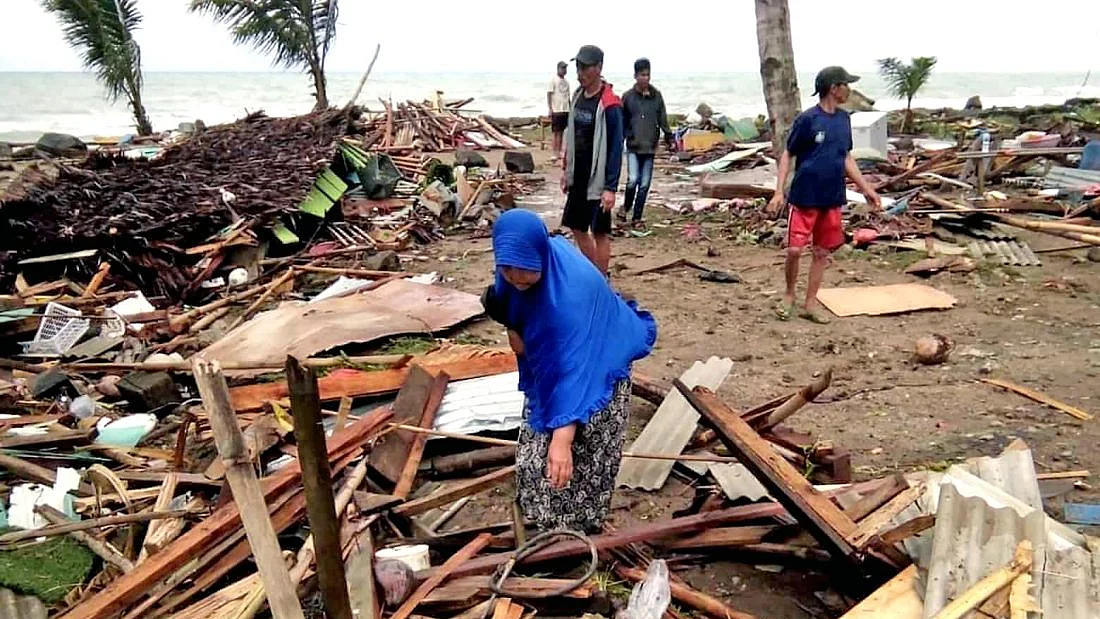Indonesia: death toll rises to 222 in tsunami caused by Anak Krakatoa volcanic eruption
About 222 people have been killed and thousands injured after a tsunami hit the coast on Indonesia’s Sunda Strait, govt officials said. Among the areas hit was the popular Tanjung Lesung beach resort

At least 222 people have been killed and thousands injured after a tsunami hit the coast on Indonesia's Sunda Strait, government officials said on Sunday.
There was no warning of the advancing wave that struck on Saturday around 9.30 p.m., the BBC reported. Deaths have been reported in the Pandeglang, Lampung and Serang regions.
The BBC report said there were reports that the death toll in Lampung province alone could be in the hundreds. Sutopo Purwo Nugroho, national spokesman at Indonesia's disaster agency, tweeted footage of the damage in Lampung.
The national disaster management agency warned people to stay away from the coastline due to fears of another tsunami. Among the areas hit was the popular Tanjung Lesung beach resort in west Java.
Emergency officials were investigating whether the tsunami was caused by Anak Krakatoa, a volcanic island in the Sunda Strait.
The country's disaster management agency said hundreds of buildings were damaged by Saturday's tsunami.
The possible cause of the tsunami is being said to be undersea landslides after the Anak Krakatoa volcano erupted in the Sunda Strait, which is between the islands of Java and Sumatra and connects the Java Sea to the Indian Ocean.
Volcanologist Jess Phoenix told the BBC that when volcanoes erupt, hot magma pushes underground and can displace and break through colder rock. This can trigger a landslide.
But because part of Krakatoa is underwater, she said "instead of just causing a landslide, you get an undersea landslide which pushes water as it moves." This can then cause a tsunami.
The disaster management agency said that high seas as a result of the full moon may also have contributed to the strength of the waves.
Footage shared on social media showed a large wave crashing into a tent in the resort, in which a popular Indonesian rock band, Seventeen, was performing.
Members of the band were seen being swept away as the wave destroyed the stage. In an Instagram video, singer Riefian Fajarsyah, said the band's bassist and road manager had died, and that three other band members and his own wife were missing.
The country's Red Cross said it was on the scene and searching for victims in the rubble of one collapsed building.
Oystein Lund Andersen, a Norwegian volcano photographer, who was on the Anyer Beach in West Java, trying to photograph the erupting Krakatoa volcano, told BBC: "Earlier in the evening, there was quite heavy eruption activity.
"But just prior to the waves hitting the beach, there was no activity at all. It was just dark out there.
"And suddenly I saw this wave coming, and I had to run. There were two waves. The first wave wasn't that strong -- I could run from it.
"I ran straight to the hotel, where my wife and my son were sleeping. And I woke them up... and I heard a bigger wave coming. I looked out of the window when the second wave hit. It was much bigger.
"The wave passed the hotel. Cars were pushed off the road. We and other people at the hotel went straight to the forest (on higher ground) next to the hotel. And we're still up on the hill now."
Nugroho, initially said the wave was not a tsunami, but a tidal surge, and told the public not to panic. He later apologised for the mistake, saying there had been confusion because there was no earthquake.
Earlier on Sunday, a tsunami warning went off by mistake, causing widespread panic. "A tsunami siren in Labuhan Bay in Pandeglang regency started ringing all of a sudden, without any activation from the authorities," Nugroho said.
"There was possibly a technical error that made the sirens ring. Lots of people ran to save themselves... tsunami shelters are now packed."
Indonesia is prone to tsunamis because it lies on the Ring of Fire - the line of frequent earthquakes and volcanic eruptions that circles virtually the entire Pacific rim.
In September, more than 2,000 people died when a powerful earthquake struck just off the central Indonesian island of Sulawesi, setting off a tsunami that engulfed the coastal city of Palu.
On 26 December 2004, a series of huge waves triggered by a powerful earthquake in the Indian Ocean killed about 2,28,000 people in 14 countries, mostly in Indonesia. However, tsunamis caused by volcanic activity like this are less frequent.
Follow us on: Facebook, Twitter, Google News, Instagram
Join our official telegram channel (@nationalherald) and stay updated with the latest headlines
Published: 23 Dec 2018, 3:01 PM